Sometimes it really is about the destination and the journey is just a bonus. I wrote about our exhilarating journey on a jet boat down the Sigatoka River in Fiji last week. But, the main reason we went on this tour was to visit an authentic Fijian village. Fiji evokes beaches and resorts but it is also a developing nation and its rural life inland is also worth exploring. See why this village visit left such a lasting impression on us.
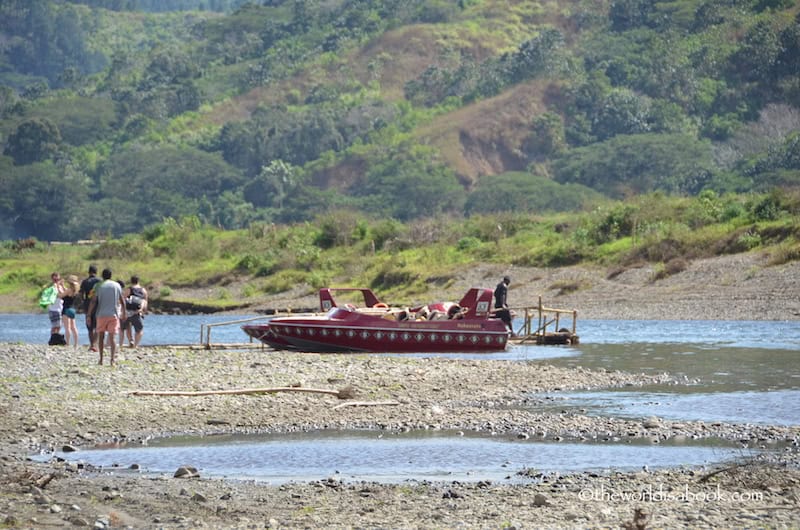
Sigatoka River Safari works with and visits 15 villages along the river. The tour is rotated so most villages receive visitors once a week for six consecutive months. Some portion of the tour tickets go to help villages. This made it easier for us to pay the high ticket price knowing the villages will also benefit. The villages have used these funds for projects that ranged from building footpaths, renovating community halls and improving schools.
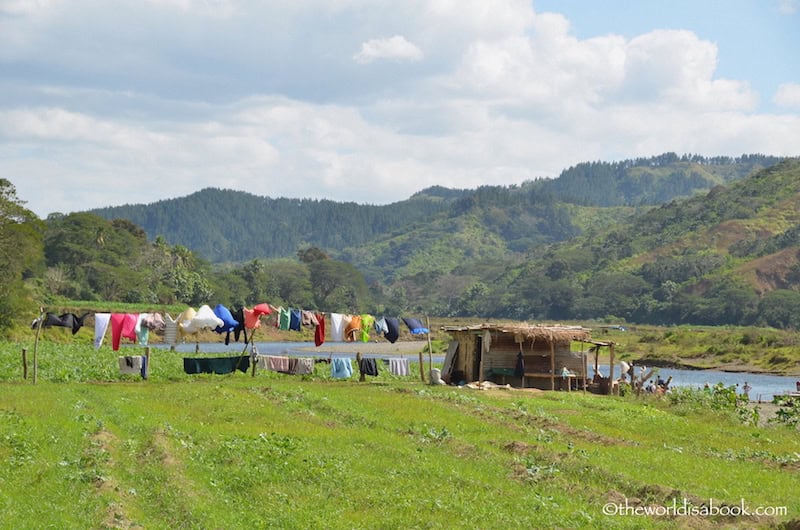
After our scenic cruise down the river for about 30 minutes, we stopped to cross the makeshift bridge to the rocky shores of Natawatawadi Village . There were a few children who gathered to welcome us. We were warmly welcomed by Aggie, our village hostess, with an enthusiastic Bula! (hello).

She instructed us to remove any hats and for the ladies to wear the sulu or sarongs we were given earlier and wrap it around our lower halves for coverage and as a sign of respect. It was a pleasant walk along the pathway up to the village. We saw plants and gardens but didn’t see many animals except for a few cows and a couple of horses.

We were welcomed at the village by more locals with genuine smiles. A few of the kids approached us and hung garlands made of leaves and flowers around our neck. They were beautiful and the flowers smelled very nice.

We were caught off guard when they put white talc powder on our cheeks. Yes, it was the actual Johnson’s & Johnson’s type baby powder. I never did catch what this was for.
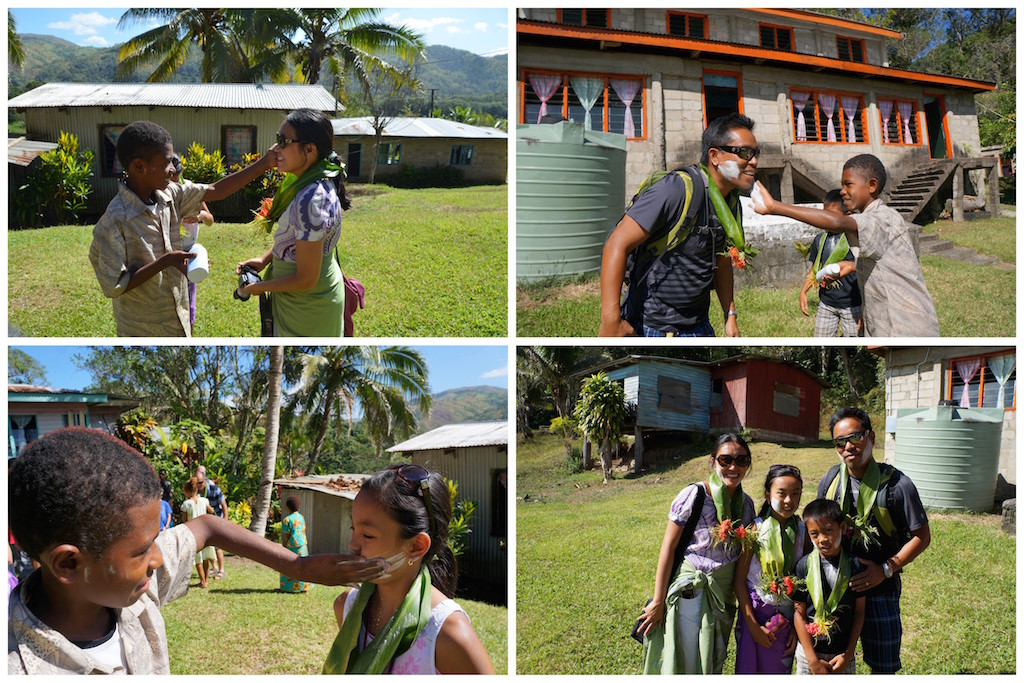
These villages are self-sustaining and have a chief or leader. Many of the houses were made of tin and some brick with tin roofs. I was instantly brought back to visiting farms in the Philippines as a child with rural scenes very similar to this village. It was simple and modest and it did look like they had electricity.

This was a real eye-opener especially for anyone who has never really set foot in a rural village including my kids. It was humbling and makes one reflect on what we have and appreciate what we take for granted like running water, food and modern appliances among many other things. This was authentic with no signs of commercialization or tourist traps.
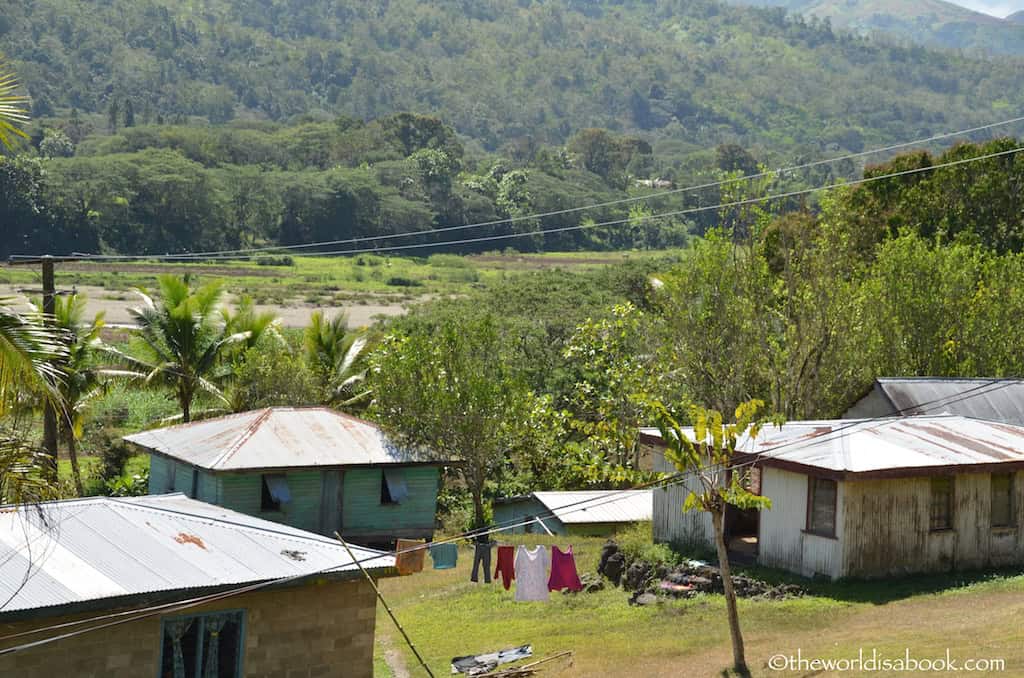
The two-story concrete structure that stood on top of the hill was the community center where the villagers gathered. We were ushered in and took our shoes off to enter. There were grass mats scattered around the room for us to sit on. The village chief faced us with the villagers sitting behind him. There seemed to be a whole lot more people here than the houses we saw outside.
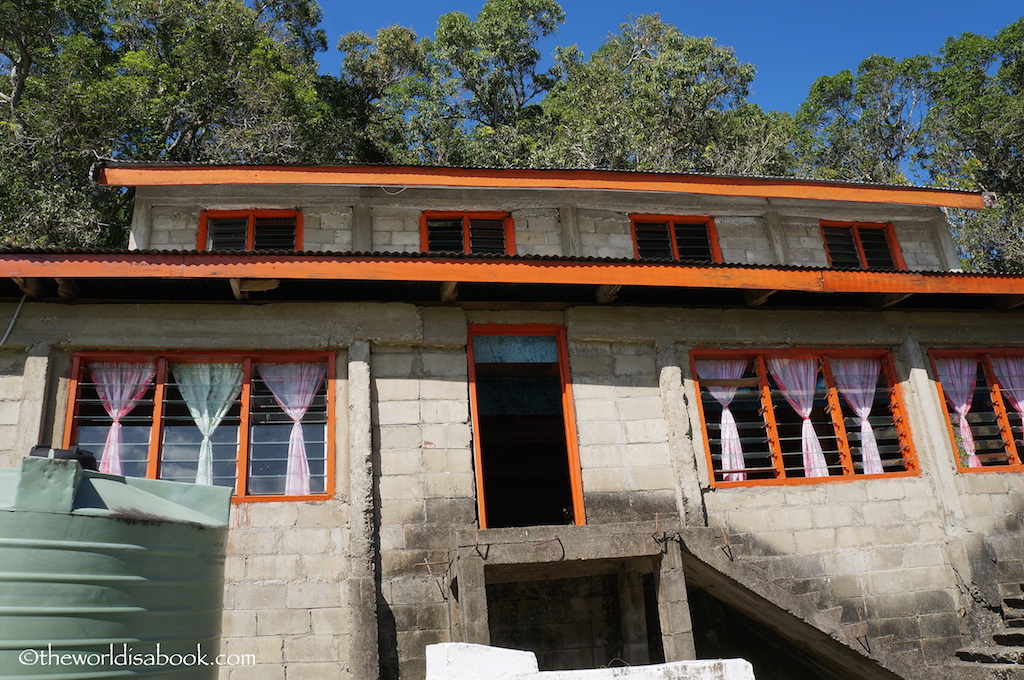
The traditional “sevu sevu” welcome ceremony started when our designated chief (the oldest male in our tour group) gave the village chief our gift of kava root or Yaqona. Kava is Fiji’s national drink and there’s a whole ceremony to preparing and drinking it. One of the jet boat drivers actually presented it to the chief talking in Fijian language. We then watched the men mix and strain through a cloth the plant’s powdered root with water in the traditional tanoa bowl.
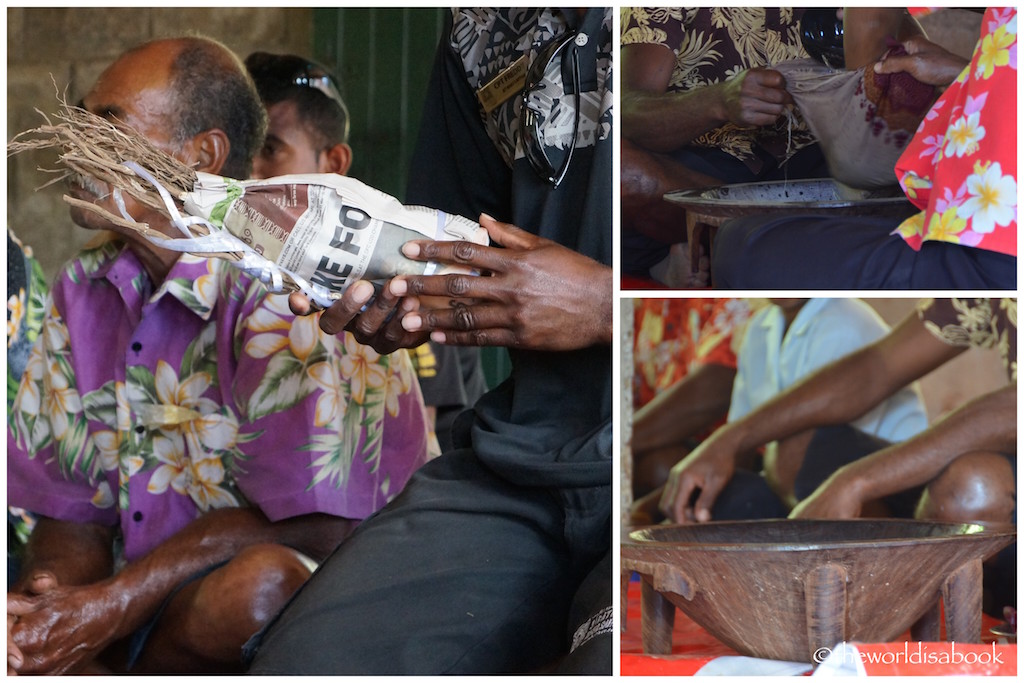
The kava mix is poured into a half coconut shell or bilo. It was offered to our designated chief and followed by the village chief. It was then passed around to the guests who wanted a drink including the kids. Each guest had to clap once, yell Bula!, drink all of it at once and clap again three times after drinking. It was quite interesting to see the other visitors’ reactions after tasting it for the first time.
Our whole family participated in a kava ceremony in downtown Nadi the day before so we knew the ritual and what kava tasted like. The kava plant is from the pepper family and the drink is a brown, muddy-looking concoction, which resembles its taste. There’s a strong, earthy, bitter aftertaste. My kids and I opted out of this one and they said it was okay to refuse. But, my husband eagerly drank the kava again and he said this mix was a lot stronger. Kava is believed to be good treatments for anxiety, stress, insomnia, and headaches. So, don’t let its appearance deter you.

Introductions were made and we met the village chief. I really liked that they started with saying we were honorary members of their village now so they wanted to get to know all of us. All of the tourists went around the room and introduced ourselves including where we lived and what we did.
We were the only Americans there. A majority was Australians, which was no surprise considering Fiji was only a few hours flight from most of their major cities. Our group was quite an interesting mix of professions that ranged from dairy farmers to physicians.
Aggie led us upstairs for some sort of Q & A. She told us a little bit of what our visit would entail and about village life. We learned that the kids in this village went to school on a neighboring village and had to cross the Sigatoka river everyday. There are no bridges or boats so they do have to wade into the river even when it’s high. They brought a change of clothes. The bigger kids sometimes carried the smaller kids.
It was heartbreaking to hear how much they have to go through just to get an education. We also learned that the chief of the village is determined by lineage instead of age or other factors. Women are still considered part of their village even if they move outside after marriage.
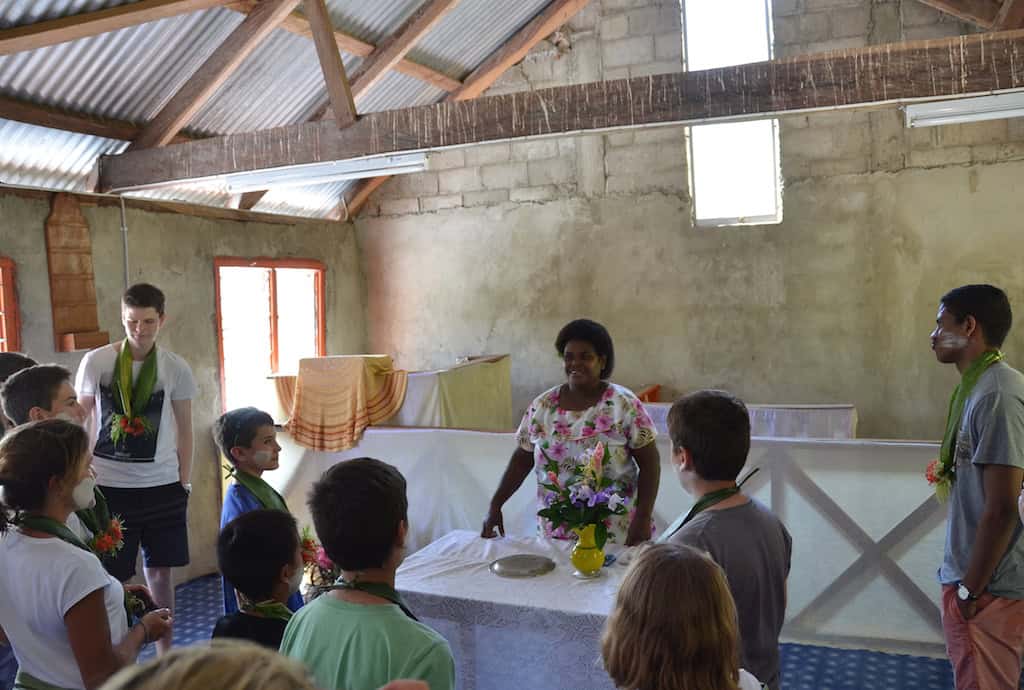
It was such a pleasant surprise to come downstairs afterwards and find a feast spread out for us. The villagers had set up a long cloth mat filled with plates, glasses and many individual Fijian dishes and fresh fruits. Many of the unfamiliar and homemade dishes all looked so delicious. We took a small portion from every dish which I highly recommend doing. You never know which one will appeal to you. I loved the cassava and the flatbread-wrapped dish.
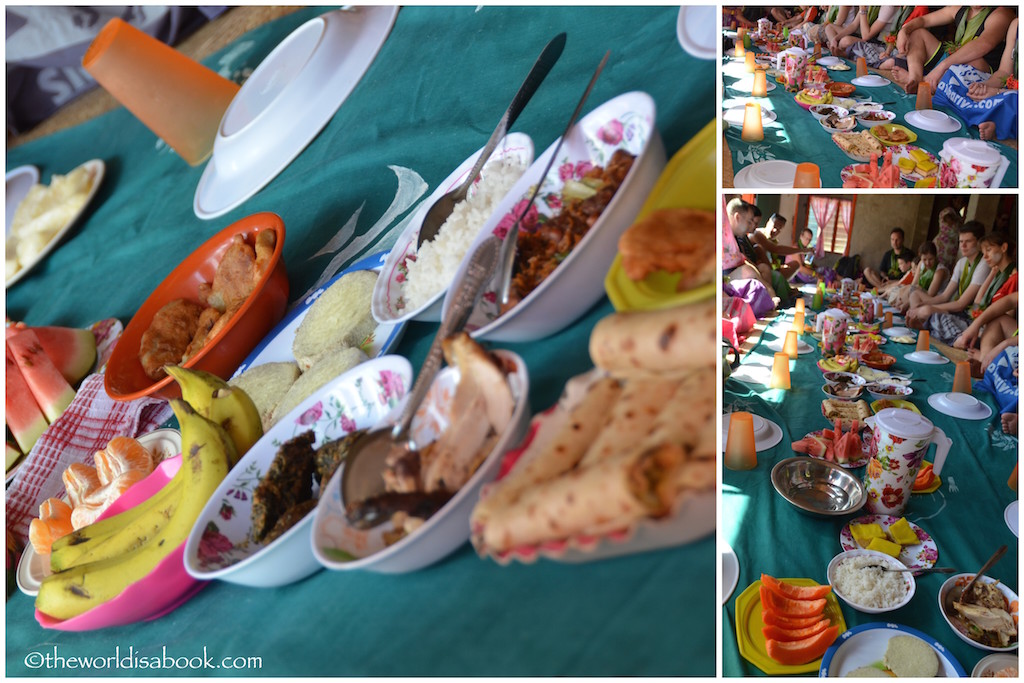
I was surprised to see my usually picky eater daughter trying out dishes and actually eating them. She loved the fruits especially the papaya which was probably picked just a few minutes before it was served.
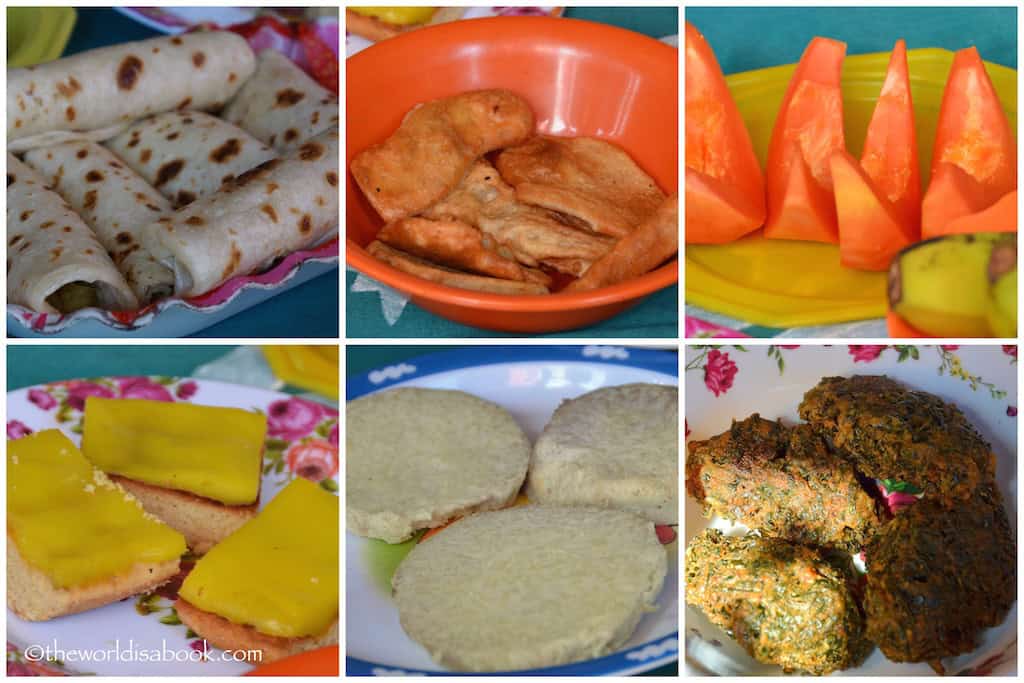
As much as we loved the feast laid out before us, it was also a bit uncomfortable as we all ate and the villagers watched us from the other side of the room. It was even more disturbing to watch the kids looking at us. My husband and I (and probably the other visitors too) wanted to offer our food but was unsure if were supposed to or if that was against some sort of rule.
In hindsight, I wish we had asked one of the locals. It was probably a cultural practice to let the visitors eat first but it probably would have been more fun if the villagers joined us and explained what the food was and showed us how to eat some of them properly.
As we were digesting our food, the village musicians sang for us. It was so uplifting to hear the children join in. We were then encouraged to stand up and form some sort of line dance. The villagers took our hands and led us around the hall in some sort of choreographed traditional dance. We just went with the flow and it was so much fun and festive.

As we were saying our goodbyes, I turned around and found my husband enjoying another round of kava with the villagers. He couldn’t pass up their last offer. He said it’s not like he’ll have another opportunity to drink kava in a Fijian village with its chief anytime soon. He does have a point.

We loved how friendly the kids were and how they enjoyed posing for pictures and readily whisked out the “V” or peace sign with their fingers. The Fijian kids gravitated towards the kids in our group including mine and happily posed with them. They also made sure to include everyone during the dance. One of my kids’ favorite moments on this trip was meeting the village children.
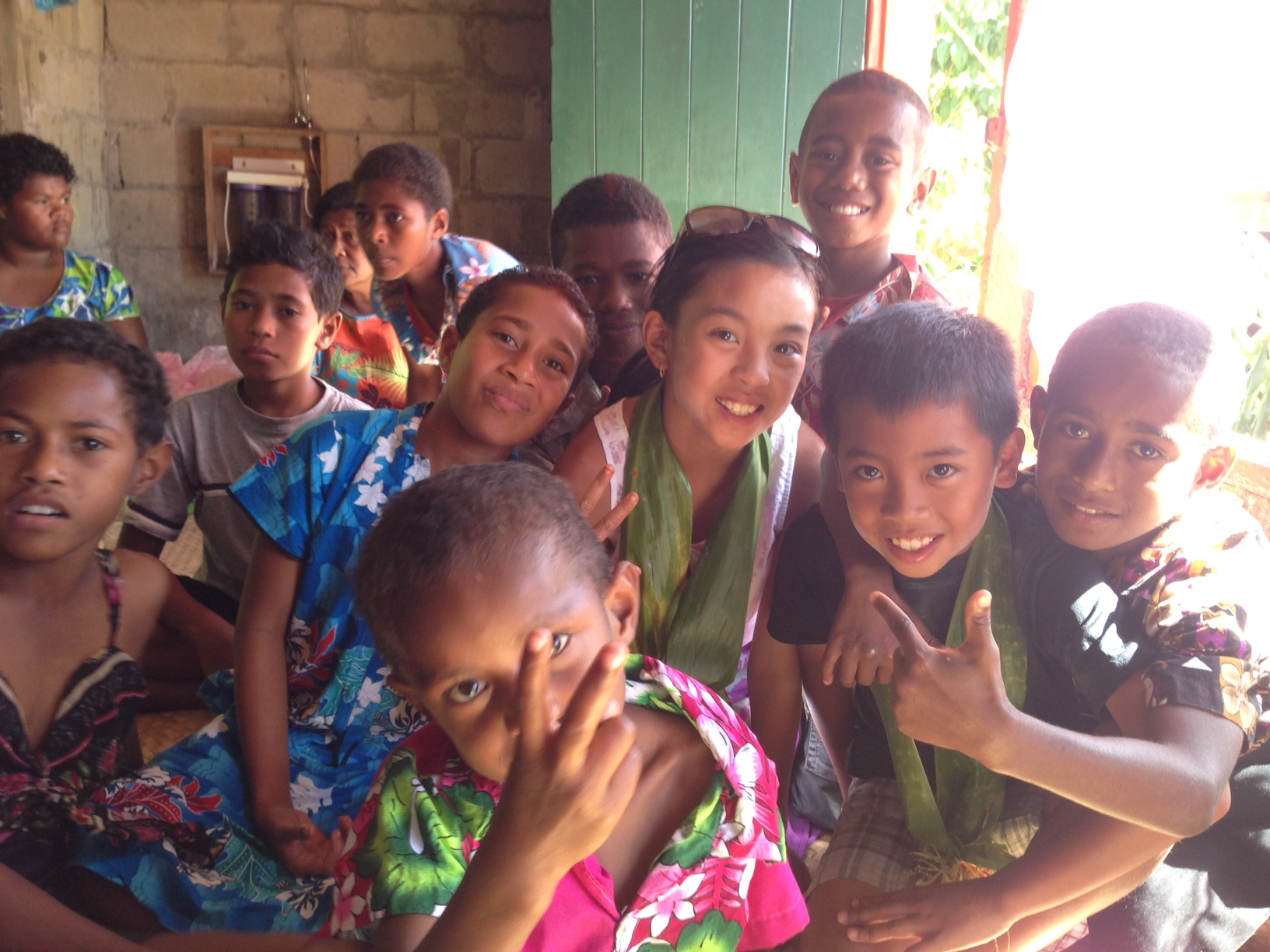
We’ve been guilty of choosing destinations that were commercialized and never included a traditional village visit in another country until now. We’re looking at some destinations and tours from a new perspective now. This experience has made my kids appreciate what they have and not take what they’re lucky to have for granted. They tend to look at things, especially their food, a little differently after this visit. They’ve also learned that there is a world out there where kids are happy and are having fun without an electronic gadget in sight. Travel is always a learning experience.
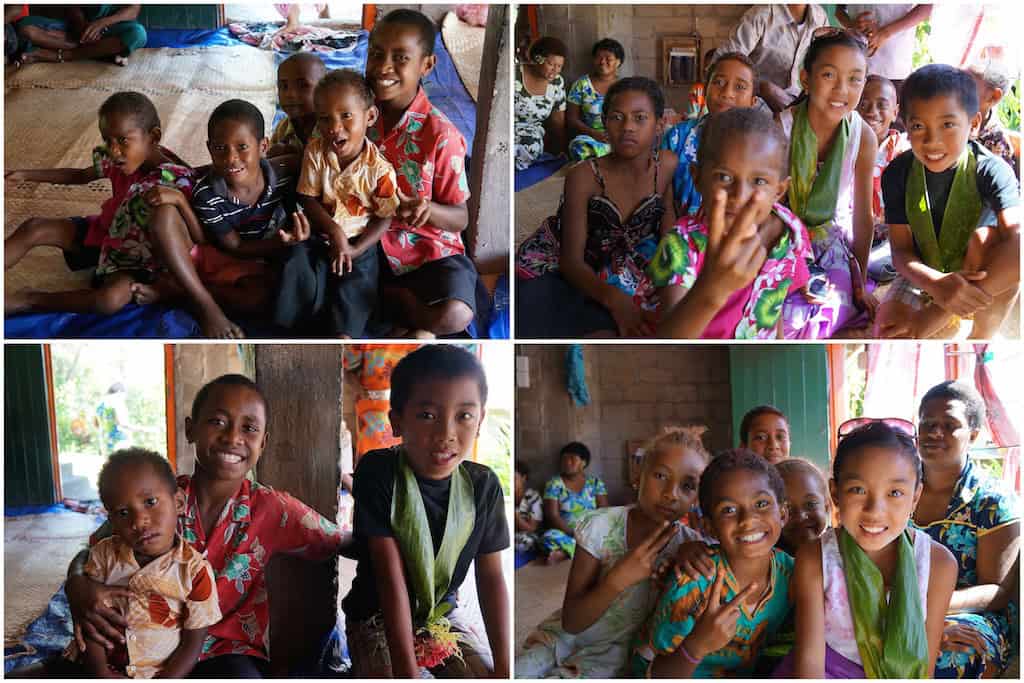
On some occasions, I’ve countered my kids’ complaints with “Remember those Fijian kids…’” and that seems to bring them down a notch. I’m still trying to figure it out and it’s on my long list of things to do to send some school supplies and books back to the village. Sometime after we got home, my 9-year-old looked through his things and said, “I think the kids from Fiji will like this. Can we send it to them?” Bless his heart!
Interacting with the villagers reinforced what we’ve experienced during our short visit in Fiji. The Fijians are some of the friendliest and welcoming people we’ve ever met during our travels.
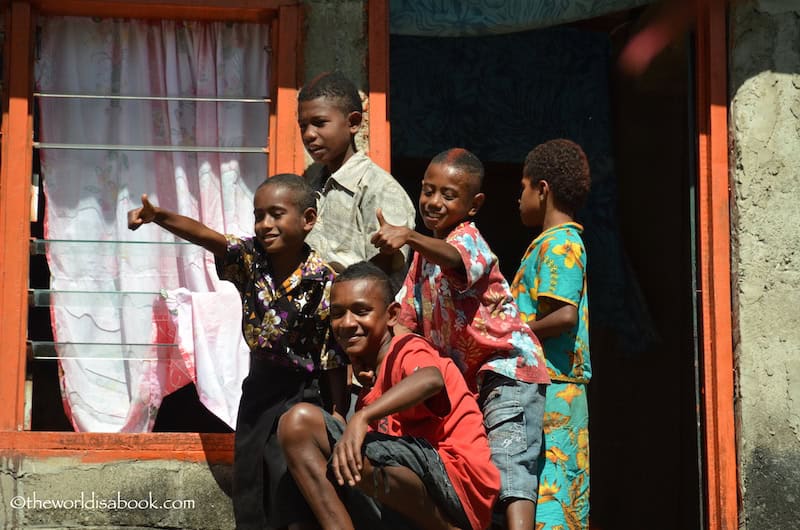
It was a privilege to share a few hours with the villagers and learn a little bit about their lives and culture. We were so touched with their hospitality. For those few hours, we really did feel like we were a part of their village. It was an unforgettable, priceless and rewarding experience for our whole family. Many of my fellow tourists shared the same sentiment as we walked back to our jet boats. Don’t miss this tour to experience Fiji, its people and its culture.

Village Visit Tips and Basics
- This tour was included with the jet boat safari and round-trip transportation from your lodging. There is a morning and an afternoon tour. Prices vary depending on hotel location for pickup.
- Pricing sample for pick-up in Denarau (where most of the resorts are located): Adults $299 FJD ($146 USD) Children (4-15) $150 FJD ($73 USD); Family Pass (2 adults, 2 kids) $850 FJD ($415 US); Kids under three years old are free. It’s not cheap but definitely worth it. Check the Sigatoka River Safari website for the latest prices.
- There is an outhouse but don’t expect modern conveniences you’ll find in the western world.
- It may be a good idea to bring your own water for hygiene purposes and if your stomach is sensitive. For the record, we drank the juice and ate a lot of food and we didn’t get sick.
- Bring school supplies, toys, books, games, balls, etc. for the kids. There were only a few of us who did this so it wasn’t widely advertised by the company. I found out from reading Trip Advisor reviews. All the gifts are gathered by the hostess and shouldn’t be distributed to each child. Bring cash too if you want to donate. They set aside time at the end to collect everything.
Have you visited a village like this before?
The World Is A Book contains affiliate links and is a member of the Amazon Services LLC Associates Program. If you make a purchase using one of these Amazon links or any of the product links, we may receive compensation at no extra cost to you. See our Disclosure Policy for more information.
Book these other Fiji Tours!
Pin it for later!
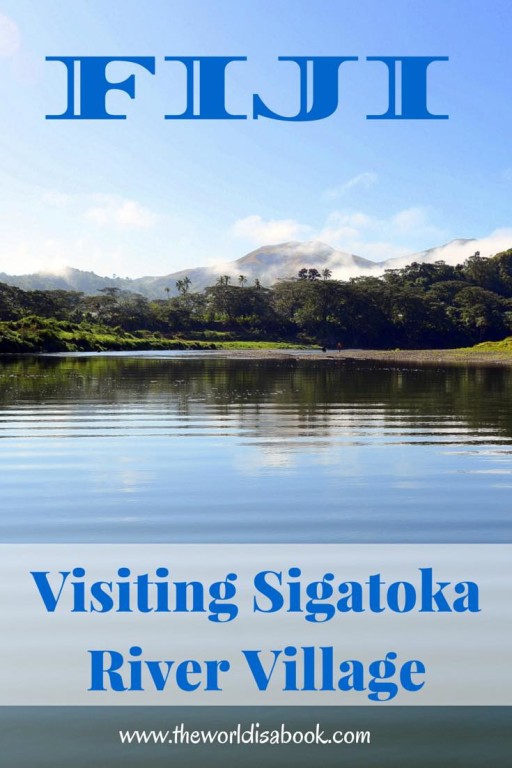
Lovely photos :)
Thanks Lili!
I have a thing for bridges and I love the picture of the little make-shift one!
Isn’t that neat? We saw a few of those around the river.
Great pictures and story! It’s so nice to see something on the real Fiji and not just another all-inclusive resort. When we were in Fiji we spent almost all of our time traveling independently and got to see — and visit — a few villages, some like this, some more traditional. We also spent time some of the Indo-Fijian villages, which are very different again. Good for you for getting out to check out at least a little of the real Fiji!
Thank you! It really was a true Fijian experience. I’m so glad you got to see the villages too. We’d love to explore more of the villages. The Indo-Fijian villages sound interesting too.
There’s absolutely nothing like visiting a local village. We had a chance to boat upriver to visit the Embera in Panama’s remote and rugged Darien province. While we were there we were able to see how they really live and purchase their exquisite handicrafts without paying a middleman. It was an experience we’ll always treasure.
I know how you feel, Linda. We just saw a special on the Embera recently and it was so interesting. What a great experience for you.
This is just inspiring and introduced a different side of Fiji to me. Thanks for sharing this and for consolidating Fiji as a place we must visit!
Thanks Monique. I hope your family visits Fiji soon.
That would have been an uplifting and challenging experience. I feel your awkwardness at eating while the villagers looked on. It is so difficult to know how to handle cultural situations like this. Maybe your tour leader could have helped out with that. It is an expensive trip and I wonder exactly how much filters back to the villagers.
It was quite an experience, Jan. We didn’t really have a tour leader and it was more the jet boat driver who served that role. We really should have asked but it was awkward since they were sitting far from us. In hindsight, we really should have asked and probably learned something new.
The village looked like any rural villages you can find in the Philippines. The food looked delicious, too. But I agree, I wouldn’t feel comfortable eating as well when others are just looking on. Maybe you can tell your tour leader about it? They can incorporate any changes in other tours.
Very true, Aleah. My husband and I both realized it looked a lot like the Philippines rural villages. I’m sharing this post with the company and hopefully they can emphasize the eating part with their jet boat drivers who also acted as our tour guide. It may also be a cultural thing to allow the guests to eat first.
I like that this experience is much more authentic than simply visiting a “fake” Cultural Village set up specifically for tourists. On the opposite side of the spectrum, I’ve been to some rural villages in SE Asia where we were basically just walking through the lanes and looking around. It sometimes feels a bit intrusive since it’s not setup for tourists. That your river village visit was an organized outing where they were clearly expecting you strikes a nice balance. I certainly hope that money goes back to the village since it seems like they spent a significant amount of time with the group as well as feeding you. I wonder how much they get? Bringing school supplies and other donations definitely seems like a good idea. This looks like a wonderful outing and one that has had a lasting impact on your kids. It definitely makes my own kids’ walk to school not seem so bad.
Thanks Michele! You’re right that this was a great balance in introducing us to the villages and a way to make it less intrusive to the villagers. I think I remember reading that the villages get at least 10% of the tour proceeds.
I don’t know why it caught me so much in this post but how much your daughter has grown over the past year!! I know that’s a silly obvious remark because of course, she’s a growing kid. But, it just really caught my attention here. Anyhooooo, I’ve heard so many good things about the Kava plant and I soooo wish I could try some. It’s purported remedies would be perfect for me! I love how you guys blended in though I can sure appreciate you feeling a bit uncomfortable and awkward at times. Fantastic post Mary and I hope you guys have a great weekend! :)
Thanks Mike! She has grown a lot and is now borrowing a lot of my clothes and shoes. I sure hope you can try Kava sometime soon for the ailment part. Have a wonderful week!
Mary, What a wonderful experience. It seems a bit pricey, but sometimes you just have to pay to get the experience and this one seemed totally worth it! I would so put this on my list.
And, as always, I appreciate your supporting #wkendtravelinspiration Mary!
Would love to explore this side of Fiji
What a lovely experience for your children. Quite a good bargaining chip for you too if they are ever being too demanding. haha! The meal sounds like a bit of strange situation. I wonder why it was played it like that.
wow!all these photos are lovely and tell the story….Seems you all had a great time!
What a fantastic experience for the family. This isn’t the sort of tour that you often hear bout but I do think they create lasting impressions. Our cooking class with a Costa Rican family in their very modest house had a similar effect on us.
We enjoyed visiting the local village but I couldn’t do the kava.
What an interesting place to visit. Were all the dishes served vegetarian, or do the villagers have access to meat?
These places look awesome.
Have you tried to visit an indigenous tribe there?
In Fiji, and on many islands surrounding the area you can find plenty tribes which truly live and rely on the natural resources of the forest.
What an amazing opportunity, Mary! My favourite part of most trips is getting to meet the people who live there, and seeing how they actually live. We did this in Guatemala last year and I’ll never forget the wonderful people we met. Your kids will never forget visiting that village.
I have never done anything like this before but I’m sure it must be a wonderful experience! Thanks for sharing this story and also for recommendation.
What an incredibly inspiring humbling experience you had, Mary! Such travel experiences leave lasting impressions on our hearts to be remembered and devoured for a lifetime. It’s so nice to know the tours are helping in the villagers development and aiding their path to a better life. Thanks so much for sharing and inspiring other travelers like me with this story.
A very inspiring story. I commend you for choosing to expose your children to the real aspects of traveling and not just show them the “fancy” side. Seeing how little other people have compared to the abundant lives that we enjoy here in the States is humbling and mind opening at the same time. Great post.
I have always been hesitant about visits to local villages because one never really knows where the money goes. Your visit however seems like it was a lovely experience also it sounds like there is a good systsem in place to ensure that the money trickles down to those who need it the most.
Looks like a great tour, and I think they work hard at maintaining the authenticity. I’ve visited rural villages around South East Asia, and the really are a wake up call. When you see how happy people can be with what we often consider so little it is humbling. Thanks for linking up last week, and sorry I am so late getting around. Classes have started, so I’m spending a lot of time doing prep work :) #TPThursday
The food looks amazing! What a great experience!
How facinatung about the J&J welcome.. hmmmm you need to find out about that! Thanks for linking up with us for #SundayTraveler again.
I’m disappointed in you, Mary. You didn’t try the kava!!! (I’m joking, of course.) It didn’t sound too appetizing. I guess it’s an acquired taste.
Great idea to send school supplies and other gifts but find out what their postal regulations are as some countries charge duty sometimes way more than the cost of the gifts themselves.
That’s pretty cool that you guys had an authentic cultural exchange with their local people. I’m always fascinated by how geography can grow a completely different set of values and traditions. Do they know in advance when a group of tourists are about to visit them?
Hi! Yes, the villages do know when a group is coming to visit so they can prepare for the lunch.